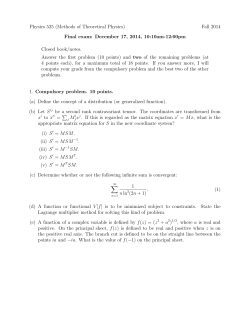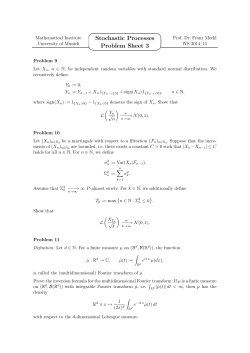
HW 7
18-290 Signals & Systems
Homework 7
Spring 2015
Total Points: 100
Submit your Solutions in three separate parts.
Make sure to write your Name and Andrew ID on each part.
Part 1 (Problem 1); Part 2 (Problem 2); Part 3 (Problem 3)
1. (28 pts) Discrete Time Fourier Series Analysis and Synthesis
x[n] =
X
ak ejkω0 n =
k=<N >
1
ak =
N
X
n=<N >
x[n]e
−jkω0 n
X
2π
ak ejk( N )n ,
(1)
k=<N >
1
=
N
X
2π
x[n]e−jk( N )n ,
(2)
n=<N >
The above pair of equations defines the Fourier Series representation of a periodic discrete
time signal. Equation (1) is referred to as the synthesis equation and Equation (2) is referred
to as the analysis equation. < N > refers to a period of the signal.
(a) (16 pts) Analysis: Find the Fourier Series coefficients ak of the following signals x[n]
for 0 ≤ n ≤ 3, where x[n] is periodic with period 4
i. x[n] = 1 − sin πn
4
ii. x[n] = 1 − sin πn
for 0 ≤ n ≤ 11, where x[n] is periodic with period 12
4
P∞
iii. x[n] = l=−∞ δ[n − 5l]
iv. x[n] is as shown below.
(b) (12 pts) Synthesis : Given the Fourier Series Coefficients ak of signals x[n], determine
x[n]
i. ak = cos 8πk
21
P
m
ii. ak = ∞
m=−∞ (−1) (δ[k − 2m] − 2δ[k + 3m])
iii. ak has a period of 15 and is as shown below.
2
2. (32 pts) Application of DTFS properties
For the following problems, note that the Fourier series coefficients of a single square wave
sequence of width N1 and period N :
1, |n| ≤ N1
1 sin[2πk(N1 +1/2)/N ] , k 6= 0, ±N, ±2N...
F
sin(πk/N )
x[n] =
←→ ak = N
0, N < |n| ≤ N/2
2N1 +1 ,
k = 0, ±N, ±2N...
1
N
(a) (8 pts) Consider a discrete-time periodic signal x[n] of period N = 5, and defined by
x[0] = x[1] = x[2] = 2, x[3] = x[4] = −1. Find the Fourier series coefficients ak of this
signal, using the linearity and time-shift property. Do not use the analysis equation.
(b) (18 pts)
i. Find the Fourier series coefficients, ak , of the signal x[n] = 1 + cos( 2π
6 )
π
ii. Find the Fourier series coefficients, bk , of the signal y[n] = sin( 2π
6 n + 4 ).
iii. Use the multiplication property to find the Fourier series coefficients of the signal
z[n] = x[n]y[n]. Do not directly use the analysis equation.
(c) (6 pts) Use the convolution property to find the Fourier series coefficients of the periodic
signal x[n], one of whose periods is shown below. Note that x[n] has a period N = 7.
Do not use the analysis equation. Hint: Try expressing x[n] as the convolution of two square wave
sequences.
b
x[n]
3
b
2
b
1
0
b
b
b
−3
b
−2
−1
0
n
3
1
2
3
3. LTI Systems and the Discrete Time Fourier Series (40 pts)
A. (8 pts) System Input (DTFS Domain)
For each input signal xi , compute the DTFS Xi (ejω0 k ) =
2π
N
PN −1
n=0
xi [n]e−jω0 kn where ω0 =
and N is a signal period. Leave your answer in a form that does not contain a
summation. (Hint: The partial geometric series formula may be useful.)
i. Find X1 (ejω0 k ) for k = 0, ..., N − 1 with N = 8 where
(
1 0 ≤ n + 8m ≤ 3 for some m ∈ Z
x1 [n] =
0 4 ≤ n + 8m ≤ 7 for some m ∈ Z
ii. Find X2 (ejω0 k ) for k = 0, ..., N − 1 with N = 4 where
x2 [n] =
∞
X
δ[n − 4k]
k=−∞
B. (8 pts) System Frequency Response
For each linear time invariant system Hi with given impulse response hi , compute the
P
−jωn .
system frequency response Hi (ejω ) = ∞
n=−∞ hi [n]e
n
i. Find H1 (ejω ) where h1 [n] = 21 u[n]
n
ii. Find H2 (ejω ) where h2 [n] = 13 u[n]
C. (8 pts) System Output
Using the computed DTFS for xi and the system frequency response Hi (ejω ), find the
series form of yi . You may leave your answer in the form of a sumation without simplification. From this, identify the DTFS coefficients of yi . Again, you do not need to
simplify your answer.
i. Find Y1 (ejω0 k ) for k = 0, ..., N − 1 with N = 8 where y1 = H1 {x1 }
ii. Find Y2 (ejω0 k ) for k = 0, ..., N − 1 with N = 4 where y2 = H2 {x2 }
4
D. (8 pts) Periodic Summation and the DTFS
Because xi [n] is periodic with period N ,
yi [n] = (xi ∗ hi )[n]
∞
X
=
xi [k]hi [n − k]
k=−∞
=
=
=
N
−1
X
∞
X
xi [k
k=0 m=−∞
N
−1
∞
X
X
− mN ]hi [n − k + mN ]
xi [k]
k=0
N
−1
X
hi [n − k + mN ]
m=−∞
xi [k]gi [n − k]
k=0
= (xi ~ gi )[n]
where gi [n] =
P∞
m=−∞ hi [n
+ mN ] is called the periodic summation of h with period N
and the operation ~ is called periodic (or circular) convolution.
i. Find g1 [n] and G1 (ejω0 k ) for k = 0, ..., N − 1 with N = 8
ii. Find g2 [n] and G2 (ejω0 k ) for k = 0, ..., N − 1 with N = 4
E. (8 pts) System Output (Periodic Convolution and DTFS)
Use the periodic convolution property of the DTFS and your previous work to find the
DTFS coefficients of each system output. Simplify to show that your results are the same
as those computed in part C.
i. Find Y1 (ejω0 k ) for k = 0, ..., N − 1 with N = 8
ii. Find Y2 (ejω0 k ) for k = 0, ..., N − 1 with N = 4
5
© Copyright 2025












